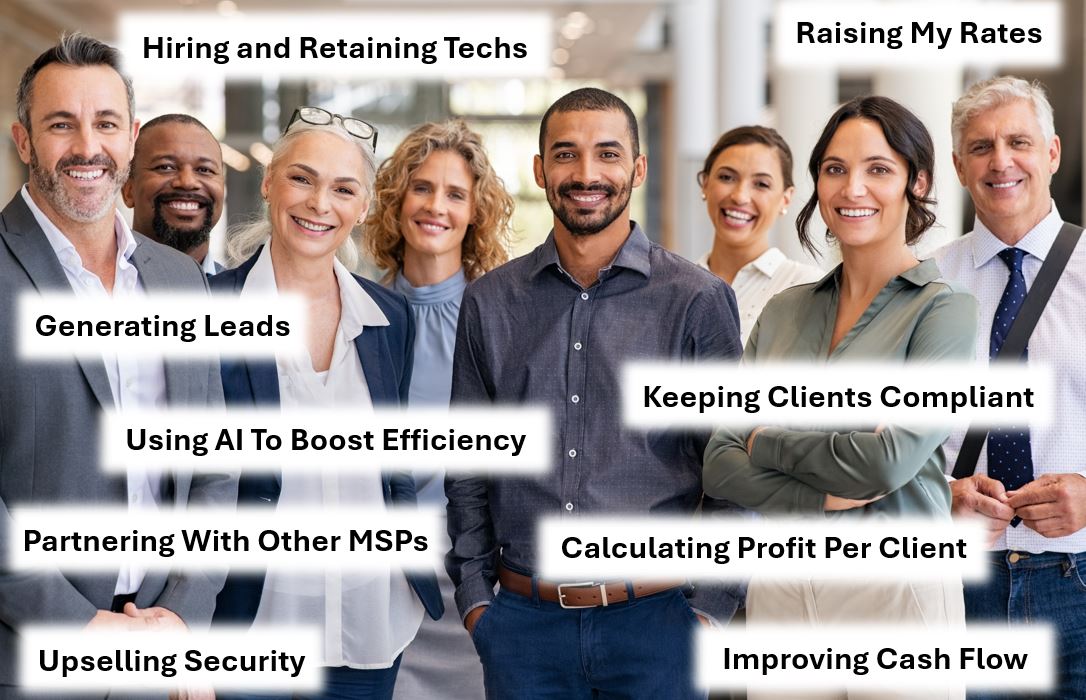Security is the No. 1 concern of business owners today. This isn’t surprising given the number of hacks, breaches, data thefts, ransomware attacks, and privacy violations that we hear about on a daily basis. And those are just the ones we know about. According to the Online Trust Alliance’s (OTA) most recent Cyber Incident & Breach Trends Report, cybersecurity incidents nearly doubled from about 82,000 in 2016 to 160,000 or so in 2017. But since so many breaches go unreported, the OTA notes that this number could easily be more than double that.
The necessity to thwart cybercriminals and protect critical business, financial, healthcare, and other data has created a tremendous opportunity for IT service providers to address this challenge while benefiting from a continually growing revenue stream.
In this series, I’ll dive deep into the topic of selling security services and cover essential topics such as the solutions available within different levels of security offerings; how to lead with security to prospect effectively and set appointments; and how to price, position, and sell these services, even if you’re not a security expert.
Overcoming Objections and Closing the Cybersecurity Services Sale
Overcoming Objections is the fifth step of the 7 Step Sales Process, and usually takes place immediately after the sales presentation of your proposed cybersecurity services, your proposal, and your return on investment/value on investment analyses.
However, the process for overcoming objections should be executed by the sales professional at any time an objection is raised prior to this point during the overall sales engagement. Proper execution of the previous four steps in the 7 Step Sales Process should minimize the number of objections the prospect would voice at this stage in the sales engagement.
It’s important to understand that an objection is typically the result of a prospect or client’s misunderstanding, or lack of information. It’s their way of saying “”slow down”” and allows us an opportunity to clarify the misunderstanding and provide the appropriate information in order to move forward in the sales process.
A few tips to avoid creating unnecessary objections include not overselling the features and benefits of your cybersecurity services at this phase in the sales process, as you should have already properly built your prospect’s buying temperature during the sales presentation phase, immediately before this point. And don’t blindly push forward towards the close, but instead confirm your prospect’s understanding of the key points of your sales presentation and the benefits of your cybersecurity solution. When the prospect has questions, recognize them and answer them. And finally, refrain from using “”sales profanity”” during the sales process.
Sales Profanity
Sales profanity includes words that can potentially decrease sales velocity or lessen the value of your services, or even the relationship with your prospect, due to the way they are perceived. When spoken, these words typically have a subtly negative effect on your prospects. Being conscious of this and making the necessary adjustments to create new habits will dramatically improve your ability to successfully navigate through the 7 Step Sales Process.
Making the deliberate decision and effort to change your vocabulary to rid yourself of sales profanity will help you be more receptive to your prospects, minimize the number of objections created, and simplify your ability to close new opportunities.
For example, every prospect wants to feel special, and using the term “”client”” instead of “”customer”” when dealing with them elevates their perception of the way you will engage with them. The term “”client”” represents a closer, more important relationship than “”customer””, which can be perceived as a less important, transactional relationship.
The word “”contract”” could be perceived as an inflexible, negative instrument. An “”agreement””, on the other hand, denotes a mutually agreed-upon decision to work together. Instead of the words “”buy”” or “”price””, replacing them with the words “”invest”” or “”investment”” positively positions your engagement with the promise of delivering a return on your client’s engagement with you and your company.
The word “”problem”” by definition denotes a serious issue. However, a “”challenge”” is something that we can work together to more easily overcome. You get the idea—replacing sales profanity words with more positive equivalents will help you reveal to your prospects the practical value of your services and build their urgency to enlist your services sooner rather than later.
4 Steps to Overcoming Objections
As previously mentioned, objections are typically a misunderstanding on the part of the prospect caused by a lack of information. In many cases, objections are created by the sales professional’s inability to properly communicate the value proposition of their offering to the prospect.
When confronted with an objection, less mature sales professionals tend to rely on techniques such as firing off pre-scripted rebuttals or re-stating the features and benefits of their solutions without taking the time to properly discover what the prospect’s true objection is.
The four-step process for overcoming objections is:
- Identify the Objection
- Acknowledge the Objection
- Qualify the Objection
- Answer the Objection
Overcoming Objections Step 1: Identify
The first step in overcoming an objection is to identify the type of objection you are dealing with. There are three types of objections: minor, major, and conditional.
Minor objections can be overcome during the sales visit, as they are typically a basic misunderstanding of the information that has been presented. For example, when a client states, “”I want to think about it””, that is usually a minor objection which can be overcome by executing the four-step process to overcome objections.
A major objection is one that can be overcome, but typically not during that visit. An example of a major objection is when the sales professional attempts to close the sale and the prospect says, “”I have to consult with my partner before I commit.”” This is usually a reflection of poor qualifying by the sales professional in step 3 of the 7 Step Sales Process, and while this objection can be overcome, it will require an additional client visit with both decision makers, at a minimum.
The third and final type of objection is the conditional objection—a requirement for doing business which cannot be overcome. An example of a conditional objection is if the sales professional were to present a solution to a medical institution that does not meet their HIPAA compliance requirements.
A conditional objection is the only type of objection that cannot be overcome, and if the sales professional conducts the qualifying phase of the sales process correctly, requirements that cannot be met with your services or solutions will be identified at that time, identifying an unqualified prospect that would never advance to this point in the sales process, and helping you avoid costly additional, and ultimately fruitless work.
Overcoming Objections Step 2: Acknowledge
Once the type of objection has been identified as minor, major, or conditional, the sales professional must quickly acknowledge the objection by simply repeating it back to them. This step is critical in overcoming objections and accomplishes two key goals. The first and most important goal is to confirm that the sales professional is listening carefully to the prospect. Next, the sales professional can process the information that was given and formulate follow-up questions to qualify and answer the objection.
For example, if the objection by the prospect is “”I want to think about it””, the proper way to acknowledge it would be to say something like “”Just so I’m clear, Mr./Mrs. Prospect, I understand that you’d like to think about it, is that correct””?
Overcoming Objections Step 3: Qualify
The third step in overcoming objections is to qualify the objection given. This step allows the sales professional to use a series of funneling questions to clearly identify what the misunderstanding or lack of information is. A common example of a sales professional qualifying an objection is clearly demonstrated in overcoming the “”I want to think about it”” objection.
“”I want to think about it”” is very vague. The sales professional must identify exactly what the prospect needs to think about in order to effectively overcome this objection. What part of the offering does the prospect need clarification on before they feel comfortable in moving forward with the proposal?
For example, if the sales professional is proposing your cybersecurity services offering and is confronted with this objection, they should highlight each and every benefit in their offering to the prospect by asking questions such as, “”Is it the antivirus, anti-malware, and anti-phishing protection that you would like to think about? (Wait for response) … “”is it the security awareness training for your entire staff, your greatest vulnerability to security breaches, that you would like to think about?”” (Wait for response) … “”Is it the internal and external security scanning and penetration testing that you would like to think about?”” “”Mr./Mrs. prospect, it sounds like these were all things you said you needed, correct?
“”Let’s be candid—is it the investment amount you would like to think about?””. In most cases, this particular objection is centered on the investment amount of the offering. After going through this exercise properly with the prospect, the sales professional has cleared up the vague objection and come to a focused objection that can now be overcome.
An important item to note here is that the investment amount should not be a valid objection if the sales professional had asked the “”budget”” question during the qualifying phase of the sales process and designed their solution to fall within said budget.
Overcoming Objections Step 4: Answer
This leads to the fourth and final step in overcoming objections—answering the objection, which is conducted by simply revisiting your sales presentation’s return on investment/value on investment analyses and clarifying the miscommunication or misunderstanding that occurred during that phase of the sales process. After the objection has been answered, the sales professional will simply ask for permission to move forward and attempt to close the opportunity.
The sales professional should always bear in mind the root cause of any objection is simply based on a business owner’s innate fear of making a bad decision. Especially when it comes to situations dealing with price, the prospect is weighing the value of your solution to their other available options.
The three options that all prospects consider during the decision-making process are:
- Doing nothing
- Attempting to fix the issue themselves
- Going with your competition
Most successful sales professionals tackle these options with the prospect and help them weigh the pros and cons of each one openly and honestly during the sales presentation phase of the sales process. When the sales professional guides the prospect through these three alternatives correctly, they build deep credibility in the mind of the prospect and accelerate sales velocity. For some prospects, not taking your proposed offering or option could be their most expensive decision when compared to their alternatives. Sales professionals develop a true trusted advisor relationship with prospects by connecting their specific emotional buying decisions to clearly illustrated logic.
The Price Objection
To put a finer point on the price objection, it invariably occurs when the perceived value of your services fails to exceed the price the prospect feels provides them a good return on their investment.
Therefore, it is critical to conduct each step of the sales process correctly to build maximum value and buying temperature in your prospect prior to attempting to close the sale with them.
Always remember that not investing in your services may typically be your prospects’ costliest option, and don’t shy away from clearly letting them know that.
Closing the Sale
Once the sales professional has properly overcome the prospect’s objections and asked for permission to move forward, it’s time to close the sale. The sales professional can simply ask “”do you have any more questions, concerns, or feedback about what we’ve covered so far, Mr./Mrs. Prospect?””
If the answer is no, they can then ask, “”Is it ok to move forward to the next step?”” If the answer is yes, this signals that the prospect is ready to be closed. If the answer is no, the sales professional will conduct the four-step overcoming objections process again until the prospect is ready to move forward to the next step and the close.
Most people think that closing is the most important step of the sales process. The truth is that closing is only the most important step in the sales process when you get to this step. Selling successfully involves a series of seven steps that must be conducted in a specific order. If you try to close before you qualify, what will you close the prospect on? If you try to close before you prospect, who are you going to close?
Many salespeople try to close a prospect before they get to other required steps in the sales cycle, or before they complete prior required steps successfully. A key to closing the sale is to understand your prospect well enough to know when the appropriate time to close is. In your sales engagements, interruptions will come, and things will rarely go exactly as planned. Your ability to adapt to changing situations is critical as you try to recognize the appropriate buying signs that tell you when the prospect is ready to move forward, at which point you will ask for the sale.
Closing is the sixth step of the 7 Step Sales Process. This step usually occurs immediately after step 5 , overcoming objections, and can be easily defined as the sales professional asking for a commitment from the prospect or asking for their business. Sales professionals sometimes make the mistake of re-explaining the features and benefits of their solution after the prospect is ready to be closed and potentially talking them out of the sale. Instead, when your prospect is ready to be closed, simply say something like, “”I greatly appreciate your business, Mr./Mrs. Prospect, so If you’ll go ahead and authorize our Proposal, we can discuss timelines for starting your services.””
Step 7 of the Sales Process: Sales Follow Up
The final step in the 7 Step Sales Process is usually the easiest, but often most overlooked step—the Sales Follow Up. This happens when you visit your client after your cybersecurity solution is implemented to explore other opportunities to help them grow their business with your services and solutions and ask for referrals to other business owners your client knows that could benefit from building a relationship with you. The Sales Follow Up, when conducted properly can yield considerable additional business opportunities for the sales professional.
Don’t miss Erick’s webinar on How to Sell Cybersecurity Without Being a Security Expert too













